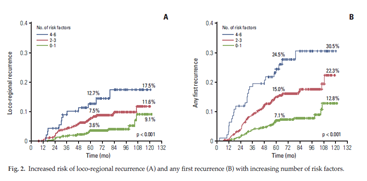글로벌 연구동향
방사선종양학
![[Cancer Res Treat. ] Incorporating Risk Factors to Identify the Indication of Post-mastectomy Radiotherapy in N1 Breast Cancer Treated with Optimal Systemic Therapy: A Multicenter Analysis in Korea (KROG 14-23).](/enewspaper/upimages/admin_20170817131046_R.png) [Cancer Res Treat. ] Incorporating Risk Factors to Identify the Indication of Post-mastectomy Radiotherapy in N1 Breast Cancer Treated with Optimal Systemic Therapy: A Multicenter Analysis in Korea (KROG 14-23).
[Cancer Res Treat. ] Incorporating Risk Factors to Identify the Indication of Post-mastectomy Radiotherapy in N1 Breast Cancer Treated with Optimal Systemic Therapy: A Multicenter Analysis in Korea (KROG 14-23).서울의대 / 박혜진, 신경환*
- 출처
- Cancer Res Treat.
- 등재일
- 2017 Jul
- 저널이슈번호
- 49(3):739-747. doi: 10.4143/crt.2016.405. Epub 2016 Oct 19.
- 내용

AbstractPURPOSE:
In a recent meta-analysis, post-mastectomy radiotherapy (PMRT) reduced any first recurrence (AFR) and improved survival in N1 and N2 patients. We investigated risk factors for AFR in N1 after optimal systemic therapy without PMRT, to define a subgroup of patients who may benefit from PMRT.
MATERIALS AND METHODS:
One thousand three hundred eighty-two pT1-2N1M0 breast cancer patients treated with mastectomy without PMRT between 2005 and 2010 were retrospectively analyzed. Only 0.6% had no systemic therapy.
RESULTS:
After a median follow-up of 5.9 years, there were 173 AFR (53 loco-regional recurrence [LRR] without distant metastases [DM], 38 LRR with DM, and 82 DM without LRR). The 5-year LRR and AFR rates were 6.1% and 12.0%, respectively. Multivariate analysis revealed that close resection margin (p=0.001) was the only independent risk factor for LRR. Multivariate analysis for AFR revealed that age < 35 years (p=0.025), T2 stage (p=0.004), high tumor grade (p=0.032), close resection margin (p=0.035), and triple-negative biological subtype (p=0.031) were independent risk factors. Two or three positive lymph nodes (p=0.078) were considered a marginally significant factor. When stratified by these six factors, the 5-year LRR rates were 3.6% with 0-1 (n=606), 7.5% with 2-3 (n=655), and 12.7% with 4-6 (n=93) risk factors. The 5-year AFR rates were 7.1% with 0-1, 15.0% with 2-3, and 24.5% with 4-6 risk factors.
CONCLUSION:
Patients with pT1-2N1M0 breast cancer who underwent mastectomy and optimal systemic therapy showed excellent loco-regional control and disease control. The patients with four or more risk factors may benefit from PMRT, and those with two or three risk factors merit consideration of PMRT.
Author information
Park HJ1, Shin KH2, Kim JH3, Ahn SD4, Kim JY5, Park W6, Kim YB7, Kim YJ8, Kim JH9, Kim K10, Park KR11, Shin HS12, Jeong BK13, Lee SY14, Kim S15.
1Department of Radiation Oncology, Hanyang University Hospital, Seoul, Korea.2Department of Radiation Oncology, Seoul National University College of Medicine, Seoul, Korea.3Department of Radiation Oncology, Seoul National University Hospital, Seoul, Korea.4Department of Radiation Oncology, Asan Medical Center, University of Ulsan College of Medicine, Seoul, Korea.5Department of Radiation Oncology, Asan Medical Center, Seoul, Korea.6Department of Radiation Oncology, Samsung Medical Center, Sungkyunkwan University School of Medicine, Seoul, Korea.7Department of Radiation Oncology, Yonsei Cancer Center, Yonsei University College of Medicine, Seoul, Korea.8Department of Radiation Oncology, Proton Therapy Center, National Cancer Center, Goyang, Korea.9Department of Radiation Oncology, Dongsan Medical Center, Keimyung University School of Medicine, Daegu, Korea.10Department of Radiation Oncology, Ewha Womans University School of Medicine, Seoul, Korea.11Department of Radiation Oncology, Ewha Womans University Mokdong Hospital, Seoul, Korea.12Department of Radiation Oncology, CHA Bundang Medical Center, CHA University School of Medicine, Seongnam, Korea.13Department of Radiation Oncology, Gyeongsang National University Hospital, Gyeongsang National University School of Medicine, Jinju, Korea.14Department of Radiation Oncology, Chonbuk National University Hospital, Jeonju, Korea.15Department of Radiation Oncology, Seoul Metropolitan Government Seoul National University Boramae Medical Center, Seoul, Korea.
- 키워드
- Breast neoplasms; Post-mastectomy radiotherapy; Risk factors
- 연구소개
- 최근 EBCTCG 메타분석에 의하면 유방전절제술 후 보조적 방사선치료가 N2 병기 이상의 환자뿐 아니라 N1 병기 환자에서도 재발율 및 생존율 결과를 향상시키는 것으로 분석되었습니다. 이 논문은 2005년 이후 유방전절제술 후 최신 화학요법, 호르몬요법, 표적치료를 시행하고 방사선치료를 생략된 N1 병기 환자에서 재발율 및 risk factor 분석을 통해 방사선치료로 재발율을 낮출 수 있는 환자군을 찾고자 하였으며 향후 이들 환자군에서 방사선치료를 선별적으로 시행할 수 있는 근거가 되는 연구입니다.
- 덧글달기
- 이전글 [Int J Radiat Oncol Biol Phys.] PSMB8 as a Candidate Marker of Responsiveness to Preoperative Radiation Therapy in Rectal Cancer Patients.
- 다음글 [Cancer Res Treat.] Effects of Postoperative Radiotherapy on Leptomeningeal Carcinomatosis or Dural Metastasis after Resection of Brain Metastases in Breast Cancer Patients.










편집위원
일반적으로 알려진 치료 방법에 대한의문점을 해결할 수 있는 하나의 근거를 제시하는 논문입니다.
2017-08-03 14:13:41